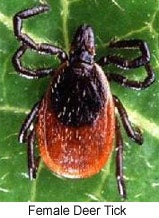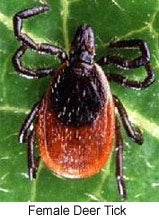 KINGSTON, R.I. — October 29, 2008 — Deer tick abundance in Rhode Island during the spring and summer of 2008 was down 24 percent from the same period in 2007, though tick counts were notably higher this year in Johnston and Coventry, according to University of Rhode Island’s Tick Encounter Risk Survey.
KINGSTON, R.I. — October 29, 2008 — Deer tick abundance in Rhode Island during the spring and summer of 2008 was down 24 percent from the same period in 2007, though tick counts were notably higher this year in Johnston and Coventry, according to University of Rhode Island’s Tick Encounter Risk Survey.
Of 61 sites surveyed, more ticks were found at 23 sites than in 2007, while 38 sites had fewer ticks. East Bay locations, which saw a significant increase in tick abundance last year, either remained the same as last year or decreased only slightly.
“It appears that disease-carrying ticks are becoming firmly established in East Bay communities, where previously their numbers — and disease risk — was relatively low,” said entomologist Thomas Mather, director of URI’s Center for Vector-Borne Disease.
Mather speculated that the overall downward trend in 2008 was due to lower humidity early in the season.
“Tick activity is dependent on environmental conditions, and they can’t survive more than about eight hours of low humidity conditions in their habitat,” he explained. “In the early part of the season this year, we had a few days of less than optimal conditions when humidity levels in forests and wooded yard perimeters fell below 85 percent for extended periods. That may have been enough to reduce tick abundance compared to 2007.”
While the active season for the tiny nymphal stage ticks ended back in July, Rhode Islanders are noticing that adult ticks are becoming particularly active now, Mather said.
“These are deer ticks, too,” he warned, “adult stage deer ticks, and they are hungry for blood.”
Although still small, the adult stage deer tick is big enough to see. Female ticks are red and black, while male ticks are all black.
“It happens every year. People often assume that bugs, especially bloodsuckers like mosquitoes and ticks, are killed with the first hard frost of fall, but that is just what brings adult deer ticks out in abundance,” he said. “It’s just a regular part of fall in New England and the mid-Atlantic states.”
Mather said that any tick seen biting humans or pets at this time of year are most likely adult deer ticks, officially known as black-legged ticks. Because they are larger than the tiny nymphal stage, they are easier to see and remove. These ticks will be active any day that the temperature is above freezing, so the URI researcher advises residents to stay alert for ticks until the ground becomes frozen, typically in early December.
“One out of every two adult deer ticks is infected with the spirochete that causes Lyme disease, which is a higher rate than is found in nymphs,” Mather noted, “so precautions to avoid tick bites should continue to be taken whenever you are outside.”
In addition to Lyme disease, these ticks also transmit babesiosis and anaplasmosis, two other serious human infections.
Mather advises residents to check themselves daily after being outside in backyards bordering woods, small wood lots, forests, and other brush-covered landscapes. Raking and removing leaves, a common task at this time of year, can put people at increased risk of encountering ticks.
“Adult deer ticks usually latch on to your legs between your shins and buttocks, and they crawl up under un-tucked shirts to find a warm attachment site,” Mather said. “If you are finding adult deer ticks around the yard, this would be a good time to hire a professional tick control expert to do a perimeter spray. And if you see adult deer ticks, then you certainly will have the harder-to-see nymphs next spring, so use the fall appearance of adult deer ticks as your warning and plan now to take action next spring and summer.”
For more information about tick identification, control and disease prevention, go to URI’s tick bite prevention website, www.tickencounter.org.

